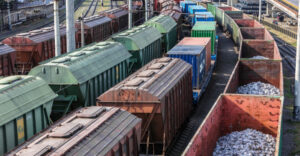
The volume of freight traffic carried by Ukrzaliznytsia in 2025 will decrease by 7% compared to last year, from 173 million tons to 160 million tons, and in subsequent years it will only be possible to increase it to 161 million tons and 162 million tons, respectively, the company announced to journalists during a presentation on November 7.
According to the presentation, it is expected that in 2025-2026, the volume of ore and manganese transportation will amount to 44 million tons compared to 43 million tons last year, and in 2027, it will decrease to 42 million tons.
Grain and flour transportation in 2025-2027 is forecast at 31 million tons, which is 22.5% or 9 million tons less than in 2024.
Ukrzaliznytsia noted that it expects a reduction in the transportation of building materials from 35 million tons in 2024 to 30-32 million tons in 2025-2027.
According to the presentation, coal transportation volumes in 2025-2027 will decrease by 17.4% compared to 2024, from 23 million tons to 19 million tons.
The company plans to partially offset these losses by increasing the transportation of other cargo from 32 million tons last year to 36 million tons this year, and then increasing it by 1 million tons annually.
Ukrzaliznytsia added that the total volume of cargo transportation from 2021 to 2025 decreased by 49% – from 315 million tons to 160 million tons. In particular, during this period, there was a 43% reduction in ore transportation, 52% in building materials, and 62% in coal.
According to the presentation, the forecast for the profitability of freight transportation is even worse: last year’s profit of UAH 20.4 billion will decrease to UAH 3.2 billion next year, and the following year, freight transportation will bring a loss of UAH 0.6 billion, and in 2027 – UAH 4.8 billion.
The company cites the freezing of tariffs, which were last increased in 2022, as the reason, although the producer price index has risen by 69.3% since then.
In September 2025, Valery Tkachov, deputy director of the commercial department of Ukrzaliznytsia, reported that the company expects freight traffic to decline this year to 162-165 million tons from 175 million tons last year, after partially recovering from a drop to 150-155 million tons in the first two years of Russia’s full-scale aggression from 312-315 million tons.
Tkachov then stressed that in order to rectify the situation, an active search for new cargoes is underway, in particular, retail and small and medium-sized business cargoes, ranging from forest products to industrial products and a large number of other segments.
Serhiy Leshchenko, deputy chairman of the supervisory board of Ukrzaliznytsia, reported last week in the Verkhovna Rada that the company’s net loss for the first nine months of this year amounted to UAH 7.195 billion.
According to him, the company proposes to index freight tariffs by 27.5% from January 1 next year and by another 11% from July 1.
The volume of Ukrzaliznytsia’s export shipments in January-June 2025 decreased by 13.5% to 38.7 million tons, domestic shipments by 11.7% to 35.5 million tons, while the volume of import transportation increased by 5.4% to 5.3 million tons.
In 2024, the company increased its revenue by 11.1% to UAH 102.87 billion, but incurred a net loss of UAH 2.71 billion compared to a net profit of UAH 5.04 billion in 2023.

Associations of mining and metallurgical, other industrial and extractive enterprises, manufacturers of building materials and cement have spoken out against increases in freight and electricity tariffs due to the risk of enterprises shutting down or a significant drop in production.
They made this statement at a press conference at the Interfax-Ukraine agency on Tuesday on the topic of “The tariff policy of state monopolies – JSC Ukrzaliznytsia and NEC Ukrenergo, their negative impact on industry and the economy of Ukraine.”
Alexander Kalenkov, president of the Ukrmetallurgprom association of enterprises, noted that the consumers of the services of so-called natural monopolies are mining and metallurgical companies, cement producers, building materials manufacturers, and the like.
“These are the main customers of companies such as Ukrzaliznytsia and Ukrenergo. Before the war, the mining and metallurgical complex, together with ferroalloy plants, consumed about 60% of all electricity supplied to industry and transported more than 40% of the traffic provided by Ukrzaliznytsia. Therefore, we are dependent on the activities of these companies, just as they are dependent on us,” Kalenkov stated, expressing hope that in the future these markets will become more competitive and monopolies will be broken up. But until then, the state must ensure that these monopolies do not abuse their position, he believes.

The head of Ukrmetallurgprom emphasized that Ukraine has the highest electricity tariffs in Europe. “In practice, this means that we are losing the competitive struggle to all entrepreneurs from the EU. I am not even talking about companies located in countries that still consume Russian energy resources—there, prices are several times lower than ours, both for gas and electricity. And that is why we are losing our traditional markets,” Kalenkov stressed.
As for railway tariffs, he said that they are currently cheaper in Poland and Slovenia than in Ukraine. “We already transport cargo by Ukrzaliznytsia at a cost that is 15-20% higher than in Europe, and there are plans to increase tariffs by another 37%. This is not only economically unreasonable and unjustified, it is a dead end,” Kalenkov said.
In his opinion, the tariff policy of Ukrzaliznytsia and Ukrenergo requires attention at the level of the Cabinet of Ministers and the Verkhovna Rada. Ideally, an independent body on transport tariffs, similar to the National Energy and Utilities Regulatory Commission, should be created. To subsidize passenger transportation, UAH 26 billion should be allocated in the budget for 2026 so as not to increase freight tariffs. Otherwise, due to the increase in tariffs, our enterprises will begin to reduce production or exit the market.
Executive Director of the Ukrainian Cement Manufacturers Association (Ukrcement) Lyudmila Kripka emphasized that two-thirds of the cement produced in Ukraine, as well as the raw materials for it, are delivered by rail. Therefore, the industry is very sensitive to unjustified increases in freight tariffs.
“We have already gone down this road, such actions have already had negative consequences in the past, and this time there will be no miracles either. This will lead to negative consequences. Manufacturers will be forced to pass on the increase in tariffs to their products, that is, to the end consumer. This will reduce consumption of products and, consequently, reduce their production and transportation,” Kripka stressed.
At the same time, she pointed out the need to develop state support instruments for energy-intensive export-oriented industries as a temporary anti-crisis measure. According to her, technical and economic criteria should be introduced specifically for enterprises in priority industries. At the same time, the funds saved from the reduction in tariffs for electricity transmission and dispatching could be directed towards investment in our own renewable energy sources.

“In this way, we would fulfill the decarbonization targets set for us by the European Union,” Kripka stated.
She cited data from the state-owned company Ukrpromvneshexpertiza, according to which a 30% increase in freight tariffs would lead to a reduction in GDP of almost UAH 100 billion, a loss of foreign exchange earnings of UAH 98 billion, annual budget losses of more than UAH 36 billion, and the elimination of at least 76,000 jobs.
Sergey Kudryavtsev, executive director of the Ukrainian Association of Ferroalloy Producers (UkrFA), noted that the majority of ferroalloy enterprises are located along the shore of the Kakhovka Reservoir, i.e., in an area close to the combat zone, where working conditions are extremely difficult. In particular, manganese plants have been idle for two years.
“We cannot transport raw materials to ferroalloy plants because the railway lines have been destroyed. And we cannot pay to transport the raw materials needed for ferroalloy production by detours. Ferroalloy plants are currently operating at 15-20% of their capacity. This situation will lead to the end of ferroalloy production in Ukraine. Imported alloys will be brought to us, and the workers will be left without jobs,” Kudryavtsev said.
According to him, this frontline zone is currently being held together thanks to the Nikopol Ferroalloy Plant (NFP), Nikopol pipe and metallurgical enterprises, but it could become “gray” if people leave.
“Today, we have problems with production, logistics, staff shortages, and electricity. This is a region that used to produce electricity, but today we get it from western Ukraine. The tariff is unaffordable for us. Therefore, we are in a situation where we may have to shut down, and it will not be possible to recover. Enterprises are currently operating at 15% capacity, maintaining a continuous process. Because if you stop a ferroalloy furnace, it will take six months to start it up again,” added the executive director of UkrFA.
Source: https://www.youtube.com/live/ATmga3Sdn3g
ELECTRICITY, FREIGHT TRANSPORTATION, KUDRYAVTSEV, TARIFF, КАЛЕНКОВ, КРИПКА

The volume of freight transportation in January-August 2025 amounted to 208.9 million tons, which is 11.3% less than in the same period of 2024, while in January-July the decline was 12.6%, according to the State Statistics Service (Derzhstat) on its website.
According to its data, rail transport remains the leader in terms of freight volume, with 106.9 million tons, which is 9.4% less than in the same period last year.
Rail freight turnover for the reporting period amounted to 67.70 billion tonne*km, which is 11.8% less than for the same period in 2024.
According to the State Statistics Service, road transport carried 77.4 million tons of cargo in the first eight months of this year, which is 9.3% less than in the first eight months of 2024.
Cargo transportation by water transport in January-August 2025 amounted to only 0.6 million tons, or 53.3% of the volume in January-August 2024.
Data on cargo transportation by pipeline and rail transport during martial law are not disclosed.
As reported, freight traffic in 2024 increased by 7.8%, and freight turnover by 13%, to 184.58 billion tons/km.
At the beginning of this year, the decline in freight transportation in Ukraine accelerated and reached 18.5% in the first four months, including a 21.3% decline in rail transportation, but since then, the decline has been slowing down every month.

The volume of freight transportation in January-July 2025 fell by 12.6% compared to the same period in 2024, to 181.2 million tons, according to preliminary data reported on the website of the State Statistics Service (Derzhstat).
It is noted that freight turnover for the reporting period decreased more sharply, by 13.5%, to 94.37 billion tonne*km, and while in terms of cargo volume in July it was possible to slightly catch up with last year’s figures – by 0.8 percentage points (pp), in terms of freight turnover it increased by 0.8 pp.
Rail transport remains the leader in terms of freight volume, with 92.5 million tons, which is 11% worse than the figure for the first seven months of last year.
Rail freight turnover for the reporting period amounted to 59.66 billion tonne*km, which is 11.8% less than for the same period in 2024. Ukrzaliznytsia explains the decline in freight turnover by the larger share of shorter shipments to ports.
According to the State Statistics Service, road transport carried 66.7 million tons of cargo in the first seven months of this year, which is 11% worse than the figure for the first seven months of last year, although the gap in freight turnover is smaller – only 4%, which indicates an increase in the distance of road transport.
Pipeline transport amounted to 21.5 million tons, a drop of 21.6%, and its cargo turnover fell by 29.2%.
Water transport accounted for a small volume in January-July – 0.5 million tons, or only 45.3% of the volume in January-July 2024, while air transport remains negligible due to the closure of the sky – 0.02 million tons, which is 19.8% less than in the same period last year.
As reported, freight traffic in 2024 increased by 7.8%, and freight turnover by 13%, to 184.58 billion tons/km.

Ukrzaliznytsia in 2024 reduced its operating profit from freight transportation by 2.3% compared to 2023 – to UAH 20.39 billion, while its operating loss from intercity, international, and suburban passenger transportation increased by 15.4% – to UAH 15.70 billion. According to the annual report available to Interfax-Ukraine, revenue from freight transportation last year increased by 10.3% to UAH 81.8 billion, while revenue from passenger transportation increased by 14.8% to UAH 10.67 billion.
As stated in the document, the largest operating profit in freight transportation was generated by the infrastructure component, which amounted to UAH 13.3 billion, up 8.3% from the previous year.
At the same time, the operating result of the rolling stock component decreased by 11.7% to UAH 6.93 billion, while that of the locomotive component fell almost fivefold to UAH 0.15 billion.
As for passenger transportation, the operating loss from intercity and international passenger transportation last year amounted to UAH 8.81 billion with revenue of UAH 10.67 billion, while suburban transportation lost UAH 9.31 billion with revenue of UAH 0.52 billion. In 2023, intercity and international passenger transportation brought an operating loss of UAH 7.46 billion with revenue of UAH 9.30 billion, while suburban transportation brought an operating loss of UAH 8.24 billion with revenue of UAH 0.56 billion.
Ukrzaliznytsia added that the operating result from auxiliary activities in 2024 amounted to UAH 2.99 billion, which is 3.7% less than the previous year, with revenue from these activities growing by 15.3% to UAH 9.78 billion.
In the report, the company noted that it is continuing its operational transformation and believes that further division into infrastructure, locomotive, and car components in the freight transportation segment, as well as disclosure of the infrastructure, locomotive, and car components in the intercity and international passenger transportation segment, is necessary for analyzing the company’s performance and further reorganization.
As reported, in 2024, the company increased its revenue by 11.1% to UAH 102.87 billion, but incurred a net loss of UAH 2.71 billion against a net profit of UAH 5.04 billion in 2023.
According to the Ministry of Economy, Ukrzaliznytsia provides more than 80% of freight and about 36% of passenger transportation within the country. The company is the largest employer in Ukraine with more than 190,000 employees and operates one of the largest railway networks in Europe, stretching over 19,000 km, of which more than 9,300 km are electrified. Ukrzaliznytsia has more than 1,400 stations and a significant fleet of locomotives, freight and passenger cars.

The volume of freight traffic in January-December 2024 increased by 7.8% compared to the same period of 2023 – up to 354 million tons.
Such preliminary data was reported by the State Statistics Service (Gosstat). According to its data, cargo turnover for the year increased by 13% – up to 184581 million tons/km.
In addition, the number of transported passengers in 2024 increased by 6.8% – up to 2.176 billion.
Passenger turnover increased by 10% – up to 43385 million passenger kilometers.
The data are given without taking into account the territories temporarily occupied by the Russian Federation and part of the territories where hostilities are (were) conducted.